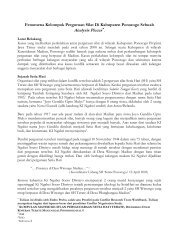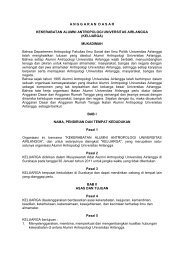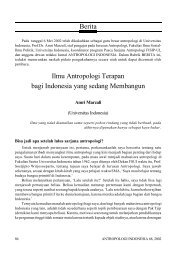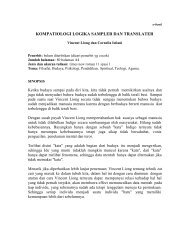The Future of Visual Anthropology: Engaging the Senses
The Future of Visual Anthropology: Engaging the Senses
The Future of Visual Anthropology: Engaging the Senses
You also want an ePaper? Increase the reach of your titles
YUMPU automatically turns print PDFs into web optimized ePapers that Google loves.
widijanto judono e-Library collection - widijanto.wordpress.com<br />
<strong>Engaging</strong> <strong>the</strong> visual 11<br />
However, during <strong>the</strong> latter part <strong>of</strong> <strong>the</strong> twentieth century <strong>the</strong> dominant practice in<br />
visual anthropology was ethnographic filmmaking, various genres <strong>of</strong> which, as well<br />
as in <strong>the</strong> USA and Britain, developed in Germany, France, <strong>the</strong> Ne<strong>the</strong>rlands and<br />
Australia (see Dunlop 1983; Heider 1976; Taureg 1983).<br />
During this period, applied anthropology also became institutionally established,<br />
but remained a contested field. From 1945 to 1975, although <strong>the</strong>re was no universal<br />
acceptance <strong>of</strong> applied anthropology in <strong>the</strong> USA a group <strong>of</strong> applied anthropologists<br />
emerged, <strong>the</strong>ir roles diversified, and anthropologists began working as agents <strong>of</strong><br />
change in society (van Willigen 2002: 31). In Britain after <strong>the</strong> 1950s, applied anthropology<br />
developed in a troubled relationship to <strong>the</strong> mainstream culminating in<br />
outright rejection <strong>of</strong> <strong>the</strong> applied by prominent members <strong>of</strong> <strong>the</strong> academy. This was<br />
strongly contested by <strong>the</strong> enthusiasm and enduring presence <strong>of</strong> applied anthropologists<br />
in Britain (see Wright 2005) but developments were more restricted than in <strong>the</strong><br />
USA. Never<strong>the</strong>less, during this period <strong>the</strong>re were some important developments that<br />
linked applied and visual anthropology, unsurprisingly in <strong>the</strong> USA, which are little<br />
reported in <strong>the</strong> existing literature. In particular <strong>the</strong> work <strong>of</strong> John Collier Jnr<br />
(discussed in chapter 5) stands out. Collier, who is best known for his book <strong>Visual</strong><br />
<strong>Anthropology</strong>: photography as a research method (1967), harnessed visual anthropology<br />
for applied research mainly in <strong>the</strong> field <strong>of</strong> anthropology <strong>of</strong> education. His work was<br />
practical, intended to lead to social intervention, scientific in its methodology, and<br />
informed by anthropological <strong>the</strong>ory.<br />
<strong>Visual</strong> anthropology was also applied in o<strong>the</strong>r ways during <strong>the</strong> twentieth century<br />
but infrequently reported. Exceptions are <strong>the</strong> 1970s and 1980s Australian Aboriginal<br />
films made by Ian Dunlop, Roger Sandall and David MacDougall, which served to<br />
bring Aboriginal issues into a public domain. <strong>The</strong>se films were sometimes made at <strong>the</strong><br />
request <strong>of</strong> <strong>the</strong>ir subjects and were produced to serve both <strong>the</strong> interests <strong>of</strong> <strong>the</strong>ir<br />
subjects and those <strong>of</strong> ethnographic filmmakers (Loizos 1993: 171). Although such<br />
films became ‘famous’ within visual anthropology <strong>the</strong>y did not inspire a literature<br />
about <strong>the</strong> applications <strong>of</strong> visual anthropology. In fact, <strong>the</strong> innovations <strong>the</strong>y are noted<br />
for in <strong>the</strong> history <strong>of</strong> ethnographic filmmaking are technological and epistemological,<br />
acclaimed for highlighting ‘<strong>the</strong> ability <strong>of</strong> <strong>the</strong> film-makers to be increasingly explicit<br />
about how <strong>the</strong> films were made and <strong>the</strong> whys and for-whoms <strong>of</strong> <strong>the</strong>ir making’ (Loizos<br />
1993: 171). Although applied visual anthropology did not emerge as an established<br />
field its practice was developed by leading visual anthropologists. As I outline in<br />
chapter 5 Richard Chalfen (better known for his academic work on family photography<br />
and home media) has since <strong>the</strong> 1970s developed an applied visual anthropology<br />
in health research. Moreover since <strong>the</strong> 1970s anthropologists have<br />
increasingly worked in indigenous media. Some <strong>of</strong> this work (for example Prins 2002)<br />
involves applying visual anthropology to indigenous issues. O<strong>the</strong>r work (for example<br />
Michaels, see Ruby 2000a) suggests anthropological approaches to producing indigenous<br />
media with and for local people. <strong>The</strong> potential <strong>of</strong> visual-anthropologically<br />
produced or informed media that lead to social interventions has long since been<br />
recognised in practice, whereas <strong>the</strong> public pr<strong>of</strong>ile <strong>of</strong> visual anthropology associated it<br />
primarily with ethnographic filmmaking.










